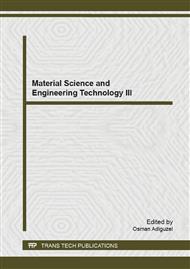p.379
p.385
p.393
p.397
p.402
p.406
p.412
p.419
p.423
Identification of Friction Characteristics and Flow Stress of 0.45% Carbon Steel during Cutting Process
Abstract:
Nowadays, numerical simulation technique is used to predict machining states such as cutting forces, stresses and temperature distribution. However, it is difficult to simultaneously estimate the stress-strain relationship of the workpiece and friction characteristics between tool-chips during cutting process. The aim of this study is to propose a new method to identify friction characteristics and flow stress of 0.45% carbon steel for FEM simulation during cutting process. Shear friction equation had been applied to estimate the friction characteristics and the Johnson-Cook (JC) constitutive equation work flow stress model was considered as a function of strain, strain rate and temperature to determine characteristics of workpiece flow stress. As a result, friction characteristics and flow stress of 0.45% carbon steel during cutting process had been estimated applying this proposed method.
Info:
Periodical:
Pages:
402-405
Citation:
Online since:
April 2015
Authors:
Keywords:
Price:
Сopyright:
© 2015 Trans Tech Publications Ltd. All Rights Reserved
Share:
Citation:


